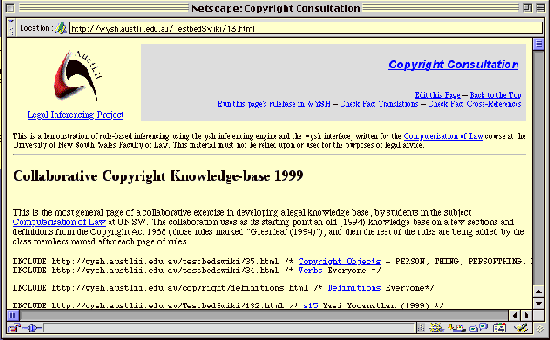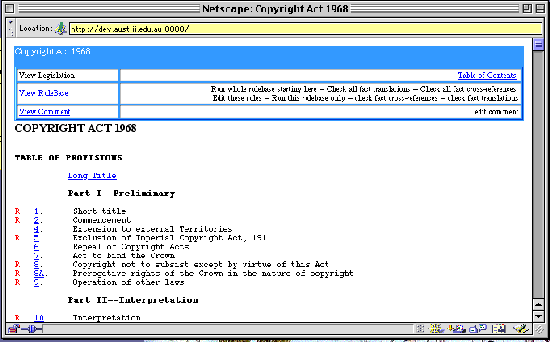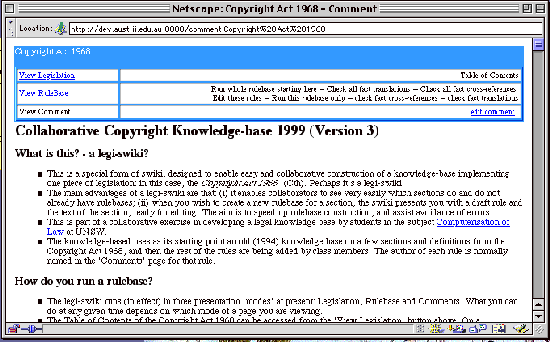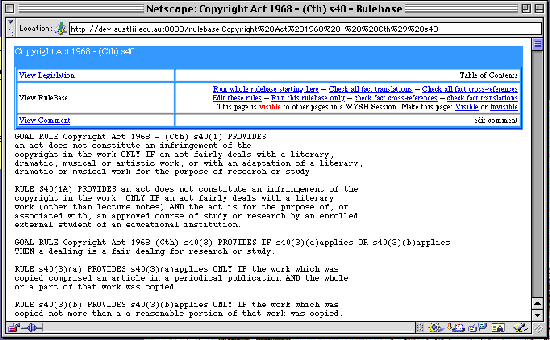With a wysh and a prayer:
An experiment in cooperative development of legal knowledgebases
Graham Greenleaf , Philip Chung ,
Daniel Austin and Andrew Mowbray
Australasian Legal Information Institute ( AustLII )
Presented at the 2nd AustLII Conference on Computerisation of Law via the Internet , University of Technology, Sydney, Australia,
21-23 July 1999.
Abstract
This paper describes an ongoing experiment in collaborative construction of legal knowledgebases over the World Wide Web. The full research and further papers are on the project home page .
1. Introduction - Cooperative Knowledgebase Development
In 1997 we described one of the more challenging issues in the Australasian Legal Information Institute's ( AustLII ) research into legal inferencing via the world-wide-web as:
'...how to enable different knowledgebase developers to co-operatively develop knowledgebases on their own web sites (all remote from the site of the inferencing software), which knowledgebases then interact when invoked by users. How can an underlying 'ontology' for legal inferencing, and use of a common interface, be best developed so that knowledge representations developed independently by different developers, and located on different servers, can interact to draw legal inferences?'
This paper discusses the tools we are developing to facilitate such 'cooperative' development of legal knowledge-bases, and an experiment in their use.
2. Development Assumptions
Research into the development of legal inferencing systems at AustLII starts with a number of assumptions (or constraints) which are unusual in the development of legal inferencing systems, and we need to explain them at the outset.
First, our objective is to build inferencing systems which form a coherent part of a very large internet site of legislation and case law. AustLII holds the complete legislation of all nine Australian jurisdictions, and the full text of over 100,000 decisions from more than 50 Courts and Tribunals. This makes us interested in converting whole pieces of legislation into knowledge-bases, possibly at a fairly low level of functionality in terms of the sophistication of the inferences which are drawn, rather than focussing on small knowledge-bases with a high level of sophistication.
Second, AustLII provides free access to legal information, and we see our work on legal inferencing in that context rather than in the context of development of commercial systems for paying users. This imposes constraints, as the funds available to develop such systems will necessarily be very limited. It also makes us interested in the development of knowledge-bases by multiple developers ('cooperative' development) and the distribution of parts of the knowledge-base across the web. This could be a means by which some groups of collaborators, such as academics expert in an area of law but located at different Universities, or practitioners in an area of law located at community legal centres throughout the country, could pool their expertise and effort to create an inferencing system.
Our assumptions are clearly not the ideal starting points for the development of legal inferencing systems. The best way to have more than one person develop a complex legal knowledgebase is to have a carefully controlled development environment. Each of the knowledgebase authors should have a good level of knowledge of the development tools (and of course, the legal domain). There should be a clear plan, protocols for conversion, good communication between all the participants, and someone in overall control.
However, this level of control is a luxury that few developers can afford, and the resulting systems a luxury that only corporate users can afford. The web is conspicuously lacking large legal knowledgebases available for free public use in part because these ideal conditions rarely exist. On the other hand, one of the strengths of the web, and the internet generally, is that it has enabled the cooperative development of many useful programs, databases and other resources in less than ideal circumstances.
It is unknown whether useful legal knowledgebases can be developed in a complex statutory domain by a group of interested participants in less than ideal circumstances.
In an attempt to answer these and similar questions, we are developing and implementing different architectures for collaboration in knowledgebase development, and have tested some of these architectures on a group of about 20 university law students, who are studying computerisation of law (see CAL pages for details). In the 1999 course the students developed a collaborative application based on the Australian Copyright Act 1968 . Quite a few students have not studied intellectual property law.
3. The Inferencing Engine And Web Interface
The inferencing engine (YSH) and its web interface ( wysh ) are described in AustLII, 1997b and documented in AustLII, 1997c.
The methods by which inferencing dialogues are linked to the legal sources on which they are based (by automated hypertext links and by linked text searches) are described here .
The wysh software, and various example applications running under wysh can be seen here .
4. Architectures For Collaboration
The architecture we are developing for collaborative knowledgebase development is a mixture of old and new software, to allow collaborations of varying degrees of coordination.
The collaborative features of the current wysh software are retained, allowing any wysh knowledgebase on the web to be linked to any other by use of the INCLUDE statement (see here for further information).This allows collaboration with a low degree of coordination, and no shared development of any web pages or joint use of other web resources. At its lowest, any one developer can simply incorporate (INCLUDE) any wysh knowledgebases which already exist on the web. At a slightly higher level, there could be coordination in the sense of dividing of a statute between participants and email communication to resolve differences over such matters as naming of shared attributes.
We are developing other tools and techniques to aid consensus and joint development of common aspects of the knowledgebase, to help ensure interoperability between the various rules which the participants create.
One tool we are using is a Wiki-Wiki website. The type of Wiki-Wiki which AustLII is currently using runs in a open source, cross platform Smalltalk development environment and is thus known as a Swiki. A plain swiki website has the following characteristics:
-
the pages of the swiki are standard HTML and can be viewed in any web browser;
-
any viewer can edit any page through his or her browser without needing any additional software, can add new pages to the swiki, and can also create new links between pages in a very simple fashion; (See how at this Wiki Wiki Website );
-
the viewer can also search for text across the whole site, as well as other more sophisticated searches (for example, searching for a list of pages on the site which link to the page currently being viewed).
Wikis are becoming more widely used in situations where a group of people (especially groups of people not under a common leader/manager) wish to jointly create something. Recent large Open Source projects, such as JOS (Java Operating System - a project to create a free operating system in Java) are using wikis to provide a common area for programmers to coordinate their (separate) activities. The use of a wiki in collaborative documentation has also been considered at Xerox Parc [Chang, 199?]. Wikis are now being used for academic purposes in fields as varied as Computer Science, Architecture and Collaborative Writing. (See some examples at the Swikis List page .
The participants in the development of the Copyright Act knowledgebase collaboratively constructed a knowledgebase where the swiki itself holds the rules, and from which wysh will run the knowledgebase. We have not found any other example of this use of swikis.
View the AustLII Swiki .
5. A Collaborative Experiment
The various stages by which students will be introduced to the tools used for knowledgebase development will provide an opportunity for us to assess to the value of the tools. As the experiment goes, each new stage is modified based on student feedback.
5.1 First Stage
The first stage of the experiment involved the loosest collaboration. The students created individual rulebases, each covering one definition of the Copyright Act and published them as individual web pages. These definitions were linked together by a central page maintained by the class teacher.
5.2 Second Stage
Stage 2 involved moving the previously created definitions to a class wiki, and distributing new sections of the Copyright Act to be translated to rulebases by the students. The results were linked to each other using the wysh INCLUDE mechanism.
Although each student could edit any page, a convention was made that students would be individually responsible for the sections they were allocated, and would jointly edit shared pages such as definitions.
The swiki, seen in Figure 1, was quite successful. The process of uploading a rule to the server and providing the appropriate links to run it was greatly simplified. However, it still did not solve all of the difficulties in creating and linking rulebases. In particular it did not hide the complex nature of INCLUDEing the correct rules, and the problem of having incomplete rules being INCLUDEd and breaking the entire rulebase.
Figure 1 The Swiki for the Copyright Act incorporating the INCLUDE mechanism
The resulting copyright rulebase .
5.3 Third Stage
Stage 3 involved a new integrated development environment, which links to the larger AustLII database of legislation. Automatic hyperlinks within the knowledgebase help the creation process, and centrally editable swiki pages enable the cooperative definition of central objects in the system. This system is available here .
The system works in three 'modes'; Legislation Mode , which acts like an alternate interface to the legislation held on AustLII; Comment Mode , in which any text can be put, such as comments on the design on the rules; and Rule Mode in which the actual text of the created WYSH Rule is put.
Figure 2 illustrates the Legislation Mode , in which the actual text of the legislation can be browsed. This is the Table of Contents of the Copyright Act 1968 (Cth). By moving into the Comment Mode , the knowledgebase creator can see what comments have been put there; in this case a small introductory tutorial (Figure 3).
Figure 2: Legislation Mode
Figure 3: Comment Mode
Rules are edited and created in the Rule Mode , (Figure 4 shows the Rule for s48). The problems with the earlier Stage 2 Swiki were partially solved by automating the inclusion of rules on the swiki, so that the INCLUDE tag was no longer needed, and allowing each creator to specify whether his or her page is visible to the rest of the system.
The system thus allows the developer to run the rulebase with his or her new rule, but won't include it in other people's WYSH sessions until the developer specifies that the page becomes visible.
Figure 4: Rule Mode (Rule for s48)
The system also aids collaboration by creating a separate 'template' web page for each section of the Act, and for each separate explicit definition contained in the Act. The assumption here is that knowledgebases which embody statutes should be isomorphic to the statute (see [Greenleaf, Mowbray and van Dijk, 1995] at 5.5), and that the segment of a statute on which it is most sensible to work is at section level.
It inserts the formal parts to commence a new rule before each subsection. The heuristic implemented here, derived from our experience in previous conversions of Australian legislation, is that you almost always need a new rule for each subsection of an Act, but there is no consistency in relation to units smaller than a subsection. The rule is assumed to be both backward and forward chaining ('RULE'), as this is the form of rule which predominates.
This automatically inserted formal part contains a consistent name for the rule, extracted from the text of the Act (eg 'RULE Copyright Act 1968 - s29(1) PROVIDES').
6. Future Work
The use of wikis in the collaborative creation of legal knowledgebases over the World Wide Web appears to have considerable potential. More experiments are planned to be conducted in the future in this interesting new area of research.
References
AustLII, 1997a - Greenleaf, G, Mowbray, A, King, G, Cant, S, and Chung, P 'More than wysh ful thinking: AustLII's legal inferencing via the World-Wide-Web', Proc. Sixth International Conference on Artificial Intelligence and Law 1997.
AustLII, 1997b Greenleaf, G, Mowbray, A, King, G, Cant, S, and Chung, P 'New Legal Services via the Web - AustLII's Research on Legal Inferencing', Chapter 5 of Greenleaf et al New Directions in Law via the Internet: The AustLII Papers [1997] COL 2, http://www.austlii.edu.au/au/other/col/1997/2 .
AustLII, 1997c - Mowbray A, Greenleaf G, King G and Cant S, 1997 Wysh Developers Manual , 1997 COL 1, http://www.austlii.edu.au/au/other/col/1997/1 .
Chang - Bay-Wei Chang 'In-Place Editing of Web Pages: Sparrow Community-Shared Documents', Xerox Palo Alto Research Center, http://www.parc.xerox.com/istl/projects/sparrow/doc/www7 .
Greenleaf, G, Mowbray, A, and van Dijk, P, 1995 Representing and using legal knowledge in integrated decision support systems - DataLex WorkStations [1995] COL 1, http://www.austlii.edu.au/au/other/col/1995/1 .
This is a Commentary published on 30 June 2000.
Citation: Allen R, ' With a wysh and a prayer: An Experiment in Cooperative Development of Legal Knowledgebases ', 2000 (2) The Journal of Information, Law and Technology (JILT). <http://elj.warwick.ac.uk/jilt/00-2/allen.html>. New citation as at 1/1/04: <http://www2.warwick.ac.uk/fac/soc/law/elj/jilt/2000_2/allen/>
|




